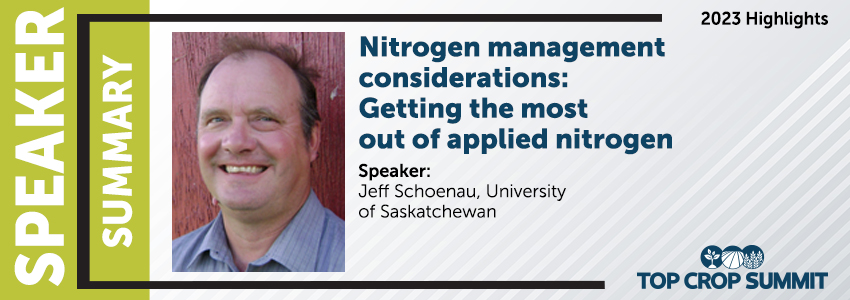
Features
Top Crop Summit
Top Crop Summit speaker series: Getting the most out of applied fertilizer nitrogen
April 10, 2023 By Bruce Barker
 Dr. Jeff Schoenau.
Dr. Jeff Schoenau. Dr. Jeff Schoenau is a professor of soil fertility and professional agrologist who works in the department of soil science at the University of Saskatchewan. He holds the Saskatchewan Ministry of Agriculture Soil Nutrient Management Chair in the College of Agriculture and Bioresources and is a fellow of the Agricultural Institute of Canada. He discussed how to get the most return from fertilizer nitrogen.
Fertilizers are often the greatest input cost on a Prairie farm. To improve the return on investment, “use it, don’t lose it” is the motto. And, that comes back to the 4Rs of fertilization: right rate, right source, right time and right place.
The right rate starts off with soil sampling and analysis. Knowing spatial variability in soil properties, productivity and yield potential across farms and fields is valuable when developing site-specific fertilizer rates. Recommendations need to take predicted crop demand, environmental conditions, soil supply and losses before crop uptake into consideration. While predicting the upcoming growing season conditions is inherently challenging, a good place to start is knowing available soil nutrients, soil properties and how much stored soil moisture is in a field and how that can contribute to yield.
Nitrogen sources from commercial fertilizers typically include granular urea (46-0-0) UAN liquid (28-0-0) and anhydrous ammonia gas (82-0-0). When properly applied, all can work well as they contain, or produce in the soil, the inorganic forms of nitrogen: ammonium (NH4+) and nitrate (NO3–) that roots can absorb.
Enhanced efficiency fertilizer additives or products, such as urease inhibitors, nitrification inhibitors and polymer-coated fertilizer are another consideration that falls under N source. These are most beneficial under high loss potential conditions, such as surface application of urea, fall application and excess moisture conditions that can lead to leaching or denitrification losses of nitrate.
Their performance can also be location specific in a field. In low lying areas of the field with wet soils prone to flooding, a nitrification inhibitor or coated urea product would likely be most beneficial while in drier, high-pH areas like eroded knolls, a urease inhibitor could help prevent losses.
Timing of application can also help to maximize N return on investment. Applying N at time of seeding reduces the risk of N loss before the crop can use it. Single pass seeding and fertilizer application is efficient, but for some, it can be logistically challenging.
For pre-plant application, a fall banded application of anhydrous ammonia after the soil has cooled or urea treated with a nitrification inhibitor are options.
Post-emergent applications, especially with dribble banded UAN, are another option. Earlier post-emergent N applications have more benefit for yield, while later post-emergent applications can provide increased protein content. Split applications in dry conditions can help mitigate risk by putting on a lower N rate at seeding followed by a top-up of N post-emergent if rain occurs, conditions improve and the crop is growing well. A split application can also help reduce losses in wet, early springs.
Nitrogen placement is best in the ground. In-soil placement reduces the risk of gaseous ammonia losses, temporary tie-up in surface straw decomposition and improves root access. For anhydrous ammonia, the gas must be banded deep enough to prevent gaseous losses, and the furrow also needs to be sealed to retain the ammonia and allow for conversion to ammonium ion. An in-soil band placement of urea will also help to prevent losses when urea breaks down in the soil.
Understanding N losses
Understanding the sources of N losses is also important in maximizing return on investment. Leaching losses can move nitrates below the rooting zone, although on an annual basis these losses are not typically large on the semi-arid Prairies. A strategy to minimize leaching loss is to avoid large accumulations of nitrate in the soil profile, which occurs when the N application rate exceeds the crop requirement and uptake. This applies to gaseous losses of N via denitrification, as well.
Gaseous losses from urea or manure via volatilization can occur when the urease enzyme converts urea that is close to or on the soil surface to ammonia gas. This can be prevented by incorporating surface applied urea into the soil by using a urease inhibitor or banding N fertilizer into the soil.
Denitrification is loss of di-nitrogen (N2) and nitrous oxide (N2O) gas forms as the result of microbial reduction of nitrate in the soil. It is a major loss mechanism in Prairie soils and is prevalent in waterlogged soils like those that occur from snowmelt run-off and heavy rains. Only small amounts are lost in nitrous oxide form – about one per cent of total N applied – but it is a powerful greenhouse gas. Strategies that encourage plant uptake of nitrogen in ammonium form before it converts to nitrate will reduce nitrous oxide emissions. Enhanced efficiency fertilizers are also effective in reducing nitrous oxide losses, but the effect on yield has been less consistent in trials on the Prairies.
Extending beyond fertilization, cropping practices that encourage efficient crop water use and reduce water redistribution and flooding in the landscape should be of benefit to farmers. Crop rotations that include a legume can supply N from the air to the crop via biological fixation in nodules on the roots, and also supply N to following crops when the legume residue decomposes. Also, ensure balanced fertility so other macro- and micro-nutrients don’t impede plant uptake of N.